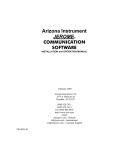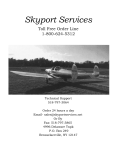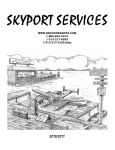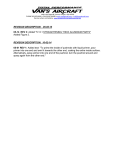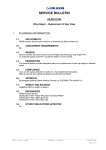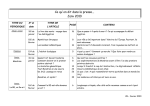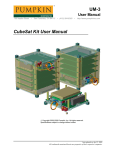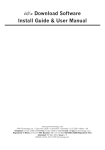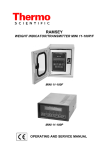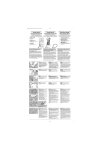Download Display Specs Page
Transcript
REBUILD OF THE BLUE MISTRESS N94694 This plane had flown for the last time about 16 years ago. It was owned by Kenneth Detjen, who worked for the aviation industry in some capacity and who had the intention to rebuild it. However, he parked the plane due to a fuel leak behind the instrument panel and never did anything else to it. It had remained in a barn on his property together with many other projects that never got finished either. Kenneth’s wife died shortly after I met him and his enthusiasm decreased thereafter. He died not much later. The plane had it’s wings removed and stacked on a frame and the cowl had been removed to get access to the generator that was missing. The cowl was loose but covering the engine. Every once in a while someone would turn the prop a few times to keep the oil moving around the engine so it would not seize up. The windows were broken and the interior was ruined. Instruments were exposed to the elements and it seemed that the only thing worth salvaging was the propeller. After Kenneth Detjen died his sister wanted to sell the property and asked one of the local neighbors to take whatever he wanted as long as he cleared he land so it could be sold. Kenneth lived in an old trailer on the property. I purchased the plane from Alton Boyett, who had rescued it from the barn, with the purpose of salvaging parts I might be able to use for my own plane. The nose gear was a double fork type that I could use and the prop appeared to be serviceable. With the help of Alton we loaded the plane on a trailer and I brought it back to Houston. Once back in Houston, the plane and it’s many loose parts were stored in my hangar. I started to evaluate what I had. The existing wings were inspected and intergranular corrosion was found in the main wing spars which was too extensive to make them airworthy. They were set aside for parts. After visiting a pair of wings in Denver Colorado that turned out to be corroded also, a set of healthy replacement wings was located in West Texas with the help of Hank Gallagher that were corrosion free and were purchased to be re-covered. Replacement wings. These wings were cleaned, inspected by Armando Montoya, primed and the leading edge covered with felt. They were re-covered using Stewart Systems process with Ceconite 120, with water based glue and paints. Once covered and painted, they were inspected again. Armando Montoya is an AA&P AI that works for Continental airlines inspecting the big planes. The double fork nose wheel gear was removed and found to be corroded. It was replaced by a rebuilt single fork gear. The propeller was sent to a propeller shop to be inspected, certified and re-pitched to be used as a cruise prop. With a 7252 configuration. The tail cone was removed and sold before deciding to rebuild this plane. A replacement was located and purchased. The landing light fairings were removed from the gear fairings and installed as taxi lights on my other coupe. New fairings were made with landing lights for this coupe. The engine was removed and mounted on an engine stand for disassembly. The existing cylinders were removed and discarded. The core was sent to American Aircraft to be rebuilt. A re-ground 10 under crankshaft was located, the camshaft was also reground 0.10 under and six new cam followers were installed. All new bearings were installed. The case was inspected and refurbished. The horizontal stabilizer and rudders were removed. The horizontal stabilizer had corrosion around the mounting bolt tubes so it was set aside for possible future repair, and later discarded. A suitable used horizontal stabilizer was purchased corrosion free together with it’s elevator which is in better condition than the existing elevator. The elevator required some repair. With the help of Gene McCay we started to remove the upper skin with the intention of replacing it but we first tried inserting a doubler that reinforced and straightened out the kinked area of the trim tab. The existing skin and doubler were riveted back on. Gene McCay is a pilot and builder having built his own RV8 Again, with the help of gene McCay, the seat structure was removed and rebuilt. The seat pan was removed and a new seat pan was made and installed with new hinges. The instrument panel was removed and found to have an overlay. The overlay was removed and discarded and a new overlay was made and attached. The new overlay is 2 1/4 inches lower to accommodate radios. The fuel tanks were removed, inspected, cleaned out, bubble tested, painted and set aside for future installation, However, when installed, they leaked and had to be resealed and re-installed with rebuilt fittings and new gasket With the fuel tanks removed a thorough inspection of the main spar showed that there was only minor surface corrosion and that the body of the plane was sound and could be rebuilt. At this point, I had to make a decision. Whether to continue to sell off parts and discard the rest or to rebuild the plane. It took several months to think about this. I am an aeronautical engineer but had never built a plane. I had designed a concept plane and a concept engine but neither were ever built or researched further. I have been a pilot since I was young and had the skills to work with my hands but had never taken on a long term project like this. After careful consideration and encouragement from both Gene and Armando, I decided I could not continue dissecting this plane when I had all it took to be able to return it to it’s former glory, or better. I consulted with Armando Montoya, my A&P, while he was doing an annual on my other coupe and he encouraged me to do it. He inspected it carefully and pointed out the items that had to be addressed. He told me much worse planes had been brought back to life. This one was too good to let it fade away. Following his advice, the belly skins were removed and used as patterns to cut new belly skins. New central skin and the two triangle shaped skins were made with new alloy one gauge thicker. They now match the same gauge used on later model Forneys and Alons that do not have the beads and the problem of belly skin wrinkles. Two new wing walk lower skins were also cut and the reinforcing ribs of the old skins were reused wherever possible and new ones were made and installed instead. To enable inspection of the rear spar, inspection ports were installed on the skins after adding doublers as recommended by the corresponding AD. Although it applied to the thinner skins, it seemed like a good idea anyhow. CORRODED BELLY SKINS BEFORE REMOVAL Once the plane was set up on it’s firewall with the tail straight up and secured to the roof rafters, a closer inspection was made of the rear spar. There was not only corrosion present but also a wrinkle and crack at the attachment point of the right rear spar. The rivets were drilled out and the whole right rear spar was removed and sent to a certified shop to be reproduced but in 0.52 gauge alloy. One gauge thicker and consistent with the thickness used on Alons. The thicker spar no longer requires the spar reinforcement kit. The wing attachment fitting was re-attached, the spar was positioned, clecoed and riveted into place. The left spar remains the original spar with the spar reinforcement in place. NEW REAR SPAR INSTALLED. NEW WALKWAY TRIANGLES By replacing the spar beam and re-attaching the original spar fitting, this qualifies as a repair and not a replacement. There was also considerable corrosion in one of the triangular wing walk reinforcement triangles so it was also replaced with a fabricated piece made by Aircraft Components of Houston. The new bottom skins were fitted with most of the original reinforcement strips, new ones were added as needed and primed where the two metal surfaces are in contact. The new skins with new inspection ports were installed on the airframe. NEW REAR BELLY SKIN TRIANGLES WITH INSPECTION PORTS NEW CENTER SECTION BELLY SKIN POSITIONED AND RIVETED. Once all of the belly skins were riveted in, the bottom was acid etched, alodined and primed with epoxy primer and the drain holes were made and angled backwards in order to create a suction when in flight. The main landing gear was completely disassembled and cleaned, and re-assembled with new grease and locking devices. The brakes were disassembled and cleaned, the right brake was discarded and replaced with a serviceable brake. New clips were installed using large POP rivets instead of the pins that have a tendency to fall out. The bearings were greased and new Desser monster retread tires were installed with new inner tubes. These tires have an extra inch of rubber which adds the necessary height to the MLG to keep the plane level with the standard number of rubber donuts and the single arm nose wheel gear. No spacers required. The brake lines from the spar down were replaced with new lines and an anchoring plate was fitted at the attachment point between the hard and flexible tubing. This solves the existing problem where the flexing of the assembly is at the old attachment point on the hard line causing the attachment bracket to wear the soft metal line. New brake lines were also installed from the T in the center of the spar and all the way to the brake master cylinder. A new flex hose was installed on the master cylinder and new hose from the master cylinder to the reservoir. The rebuilt steering mast was installed and the pushrods to the mixer and steering knuckle on the nose wheel were installed. The rebuilt mixer was installed as well as the bellcranks for the ailerons and the corresponding new 304 stainless pushrods were installed. These pushrods replace the old ones that were steel tubes and have a tendency to corrode from the inside out. The elevator horn was installed on the main spar and the cables from the mixer to the elevator horn were attached. The rebuilt instrument panel with a new overlay was installed and the throttle quadrant was attached and the trim and throttle mechanisms were connected. New cable and tubing was used for the elevator trim mechanism. The lower center panel brace was made and installed with the retainer for the throttle cable attached. A refurbished cabin heat box was installed on the firewall and a new pull cable was installed on the lower right side of the panel and attached. The carb hot air cable and pull to start cables were installed. The existing fuel tank shutoff valve and strainer was installed with an elbow to make room for the transponder tray. A panel mounted shutoff valve was installed in the line for easy fuel shut off. The primer was rebuilt installed and connected. A FARIA electrostatic fuel sensor was installed in the left fuel tank in place of the leaky float type gauge and wired to the electric fuel level gauge on the panel. This fuel sensor has no moving parts and is intrinsically safe by Eec. And ATEX standards working off voltage that is too low to be capable of generating a spark. The electronics are enclosed in a solid epoxy resin puck. Although this device was not approved for aircraft use at the time, it ha recently been approved for use as of 2010. The existing mechanical oil pressure gauge was cleaned and installed with new tubing. This is the only instrument that was original to the plane. A new WESTACH electric carb temp gauge was installed. A new WESTACH electric oil temperature gauge was installed. All three of the electrical instruments above were wired to a panel switch and to a 5 amp breaker. A new MITCHELL 60 Amp meter was installed. It was wired to a shunt on the battery box. A new altimeter was installed and connected to the static line. A new airspeed indicator was installed and connected to the pitot line. A new VSI was installed and connected to the static line. A rebuilt electric turn and bank instrument was installed and wired to a switch and the 5 amp breaker. A rebuilt artificial horizon was installed and connected to the venturi line. A serviceable DG was installed and connected to the venturi line. A serviceable vacuum gauge was installed in the panel and connected to the venturi line. A new instrument air filter was installed and connected to the venturi line. A rebuilt RPM / Hobbs meter was disassembled and adjusted to reflect 749.99 hours, (the higher of the engine time registered with the FAA and time shown on the old Hobbs meter.) and installed in the panel. This RPM meter failed and was replaced with a new one. The tach cable failed in flight later and was also replaced with a new one. An AIR GIZMOS docking panel for the AvMap EKP-IV GPS nav system was installed. The cleaned and rebuilt mechanical clock was installed in the panel. A serviceable magnetic compass was installed in the panel. A serviceable ELT remote monitor switch assy. was installed in the panel. UNFINISHED INSTRUEMNT PANEL ELECTRICAL WIRING TEST A pair of used ailerons were located in Michigan and purchased. One had to have a new top skin installed and the second one was opened, cleaned, primed, two new alloy stiffeners were installed to replace the corroded steel counterweight pad, riveted back together and painted. Four new ECI TITAN C-85 cylinders with Nickel Carbide barrels were purchased from ECI in San Antonio. The existing rocker arms were sent to be serviced by ECI. A new set of spark plugs was purchased as well as a spin on oil filter kit. Both of these were taken to Argentina and sold to local Ercoupe owners. A second spin-on adapter was re-ordered and installed. A rebuilt 60 amp FORD /Cessna alternator and new Zeftronics V600 voltage regulator was purchased for later installation with a new drive gear and vibration damper. The shaft of this alternator failed and a new rebuilt alternator and gear set was purchased. The battery box was rebuilt and painted with the solenoid, shunt resistor and alternator breaker mounted and wired to the sides. The starter cable was the only electrical cable to be re-used and all the rest of the wiring is new. A row of switches was mounted on the panel next to the breaker switches. The breaker switches were then relocated to the bottom of the panel and the location of the breakers was used to install a new volt meter and a CHT gauge. A rotary switch was installed on the bottom of the panel to select cylinders for the CHT gauge. The brake master cylinder was rebuilt twice with new O’rings and fittings. The brake line flexible hose is new and the floorboard bracket was rebuilt and installed. The brake fluid reservoir was mounted on the engine side of the firewall and connected. The brake cylinders were fitted with new bleed nipples and the brake lines were purged but not tested as the brake pedal is missing. The engine case freshly rebuilt by American Aircraft in Oklahoma, was removed from the shipping crate and installed on the engine mount using new bushings, bolts and nuts. The two upper bolts were fitted with a bracket with a nut that will allow for lifting the plane with a 3 point hoist bar. The intake spider and rebuilt carburetor were installed and the throttle and mixture controls connected. The hydraulic unit covers were installed with new silicone gaskets, washers and locknuts. The four intake elbows were installed with nylon locknuts instead of the standard plain nuts. Four new Titan cylinders with new pistons and bushings were installed with new nuts and cylinder base seals. The existing pushrods turned out to be too short and a set of .070 pushrods was ordered from Fresno and installed. The starter and alternator were installed using new gaskets, nuts and washers. The old fuel filter screen was de-soldered as instructed in the STC for the spin-on filter adapter and a bushing to adapt the new temperature sensor probe was soldered in using silver based solder. The modified filter housing was installed on the engine using a new crush washer. The oil suction tube was installed with a new crush washer and safety wired. The oil tank was installed using new composite gasket and the relevant nuts were safety-wired. The two existing Bendix S4LN20 magnetos were disassembled and cleaned and serviced according to Bendix Service manual and Bendix Service Bulletin NO 474A with new points, coils and condensers. The timing adjusted and new Skytronics shielded harness installed. The magnetos were tested and installed on the engine. The engine breather elbow was removed and cleaned and a 1 ½” length of brass tubing was brazed in according to EOC recommendations to reduce oil blow-by. The elbow was re-inserted with the outlet facing backwards and slightly elevated to aid in draining oil back into the engine. The oil tank drain plug was cleaned and a drain tap was installed. It was screwed into the tank and safety wired. There is no oil in the tank at this time. The gascolator was cleaned and re-assembled with new brass fittings according to the AD’s, and installed on the carburetor. New seals were installed and the required aluminum supporting brackets were replaced with new ones made out of 316 SS and installed according to the corresponding AD. The fuel pump was disassembled and cleaned and the fittings re-installed with new brass hose barb fittings. The outlet fitting was plugged with a brass bar, brazed and drilled with a 1/16” orifice as directed by EOC recommendations to limit the fuel pump output to 10 gpm. The fuel pump was installed with a new composite gasket, new nuts and washers. It will be safety wired after the AD inspection is done. Once in taxi tests, the pump was not working and the top half was replaced with a Airtex model 429 head which is almost the same but with bigger valves. This was not legal for flight but the replacement valves were on order. The wrong size valves arrived and had to be returned. For the flight tests the original pump head was installed with new valves provided by Antique Auto Cellar. These valves failed in flight after 9 hours and were found to be made with a new old stock component that was not suitable for current avgas used. The pump head was returned for replacement and new design valves were installed. This information was shared with the ercoupe group so other pump heads rebuilt could be inspected. The right aileron was disassembled, the upper skin was discarded due to corrosion and wrinkles. The aileron spar was repaired, cleaned, acid etched, alodyned, primed and reassembled. With two new stiffeners. The obsolete steel counterweight plate was removed and the reinforcing doubler replaced with an internal alloy doubler. A new top skin was made and installed. The left aileron was opened up, cleaned, two new stiffeners installed, the counterweight plate removed and replaced with a new internal alloy stiffener. It was primed and riveted back together. A whole new wiring harness was made and installed with the VR-600 voltage regulator mounted on the seat belt carry through triangle, the shunt, solenoid and alternator breaker and strobe unit were installed on the walls of the battery case. Strobes were installed in the existing NAV lights and wired to the wing junction. Aileron pushrods were installed and connected to the rebuilt aileron bellcranks with new hardware. The rebuilt horizontal stabilizer was installed with new hardware and the rudder horn and pushrods installed and greased. The rebuilt elevator was installed and the trim tab connected to the trim wire. Rudders were rebuilt and installed with new hardware. The entire empennage was soda blasted, acid etched, alodyned and epoxy primed. The tail tie down was reinforced internally and the tie down and localizer antenna were installed. The localizer cable was routed to the front but remains un-installed as there is no NAV radio installed in this plane at this time. It is available if one should ever be needed. The intercom was installed and connected to the radio and transponder harness. PTT wires for pilot and co-pilot were installed, the co-pilot PTT is on the panel, the pilot PTT button is on the yoke. Breaker switches for the landing lights and alternator field were installed on the lower panel pilot side. A tensiometer was borrowed and the tension of the elevator and rudder cables was checked and adjusted. The brake pedal was found, installed and tested. The brakes did not work. Brake fluid was leaking out of the left brake. It was disassembled and the O’ ring changed for a new one as the old one was defective. The brakes were purged and a brake line leaked. The flare of the brake line coupling was re-flared and that stopped the leak. The brakes were purged and tested again and they finally work. The new floorboards were installed and a new cover for the yoke hole in the floorboard was made. Serviceable indicator lights for the alternator, landing lights and test were installed. The charging system was not operating on first test. Upon examination it was found that the voltage regulator was dead. No output detected on the FIELD terminal. After consultation with Fermi Itibayo with ZEFTRONICS, it was determined that the Ford Alternator STC was wrong and that the correct regulator for this rebuilt Ford Alternator model C6FF10300-B new number D0FF10300-JR should be a Zeftronics R15V00 Rev A. with the overvoltage set point at 15.2 Amps as this model alternator puts out 15.3 Amps and not 14 amps. The correct regulator was purchased and installed. Examination of the system also found that the AMP meter was the wrong model to be used with a shunt. It was supposed to be wired with the full bus power through the meter. As this is not the safest way to do it, so a Westach model 2A6-15 Amp meter was ordered for use with the shunted voltage. It is also recommended that the alternator and the regulator have the same ground so the shielded cable for the field connection was modified so the shield is grounded both ends. All other shielded wires are grounded one end only. The final electrical installation schematic is as below with the following exceptions: Dimmer is not installed at this time. The radio light appears to be too dim and may need to be rewired at a later date. NAV COM is COM only at this time, however, a NAV antenna and coax wiring is installed. NOTE: with this installation the wire to the starter is always hot. It is no longer wired through the master switch which is usually too weak for starter loads. The battery must be disconnected every time maintenance work is being done on the accessory case or in the vicinity of the starter terminal. The above drawing does not include magnetos, radios, intercom, transponder, ELT or GPS wiring diagrams. The seat belt triangles were installed as well as the seat back. The seat pan is out at this time. Disconnected the chain on the steering column, centered both yokes in horizontal position and re-installed and tightened chain checking for the centered position of the spider and aileron pushrods and rudder positions. The nose wheel is also centered. Final adjustments of the rudder cables, ailerons and nose wheel can be done after taxi test. Installed the handbrake cable, brake pedal and floorboards. Sanded and primed the nose bowl. Installed the repaired lower engine cowl. Adjusted tension of the elevator and rudder cables again. Installed the baggage compartment cross members, seat back rear panel and made new marine plywood back panels and floor panels for the baggage compartment. Made new side panels and installed them with the master switch. Installed the seat pan and seat belts and adjusted belt lengths. Installed seat back upholstery. Cut and formed two new engine side cowls and drilled for attachment to the top cowl hinges. Formed two new side cowl stiffeners out of aluminum U channel to replace the weak L shaped stiffeners that usually break. Painted both wings with final topcoat silver. FINISHED WINGS READY FOR INSTALLATION. Washed, sanded the epoxy primer and primed the fuselage with Stewart Systems water based Eco-Prime. Ordered a new top cowl from Univair to be installed on N87333 and the top cowl of N87333 will be painted and used for N94694. As the brake master cylinder leaked again. I removed it and serviced it with new O’rings and found a leaky flare on the brake line. The L shaped beam that attaches to the stringers and the floorboards where the brake pedal attaches was weak so it was rebuilt adding a stiff plate attached to the stringers with a 3/16” bolt that bolts to the angle. This arrangement allows for much greater tension on the hinge of the brake pedal without putting strain on the floorboards. The Brake line still leaked so I removed it and replaced it with a long flexible reinforced hose right from the reservoir to the T on the main spar solving the leaking for good. The lower half of the plane was painted silver with four coats of Stewart Systems water based paint. Results were extremely pleasing. The landing gear was acid etched, washed and painted white. Once dry, the middle line was masked off and the top half was painted with three coats of silver blue. After three coats it was evident that the color was too blue. The desired color should be a grey-blue. So we mixed two parts of silver with one part of blue and produced a better result. The upper part of the plane was lightly sanded and painted with a very light fogging coat and two more coats of the combined color. The top cowl, top half of the side cowls and top half of the nose bowl were painted with the recommended four coats with excellent results. The Stewart Systems paint procedure is followed strictly as it is the only way to get good results. The part A paint is mixed thoroughly until the paint is even and all deposits on the bottom of the can are mixed in. The part A is poured into a plastic container and weighed. A maximum of 700 grams is the ideal weight for one application. Smaller batches are better for painting parts only. The weight of part A is divided by 3.3 and the resulting weight of part B is added and stirred in until creamy and smooth. The reaction time starts at this point and the maximum time is 45 minutes. The weight of part A is divided by 2.27 and the result is the weight of the distilled water to be added. The water is added gradually and the viscosity tested with a viscosity cup. Water is added gradually until a 22 second viscosity is obtained. The resulting paint is filtered and poured into the paint gun. The gun is set for 22 to 25 Psi with the trigger pulled. The paint nozzle is opened ¾ turn and the result is a very light fog. The first coat is applied very thin. The paint nozzle is opened 1/8 turn and the second cross coat is applied after 10 minutes. For the third coat the paint nozzle is opened an additional 1/8 turn and applied after 10 minutes. The fourth coat requires ¼ turn plus 1/8 more and is applied when the third coat is tacky but does not stick to one’s finger nail. It can take 10 to 15 minutes. The gun is disassembled and washed with water. The paint is set after an hour and dries overnight. The red and white vinyl stripes were added and the US AIRWAYS decals were applied. Unfortunately, the masking tape should have been the low adhesion type. It pulled the paint off when we removed it and several parts had to be sanded down to bare metal, primed and painted again. The paint scheme continued to develop and the plane just looks better and better as we progress. The windshield was cut out of plexiglass and installed. When we were on the last three screws, it cracked and had to be removed. A new windshield was cut out of Lexan and installed successfully. The side windows are also lexan and the rear windows are PEPK that is more flexible and it is installed with the rubber gaskets rather than screwed in so that it can be kicked out as an emergency exit and not leave any sharp edges like plexiglass or lexan would. With the windows in, the radio and transponder and ELT system were installed and tested. The map light was installed but not connected yet. The mating plugs on the wings for the strobes were installed. The connectors for the pitot and staic lines were installed, the ailerons were mounted on the wings with new stainless hardware. The rear baggage compartment was completed with new upholstery and the seat belts installed. A plate for the master switch was installed and lexan frames for the airworthiness certificate and registration will be attached to the rear bulkhead upholstery. The seat and other upholstery was installed. The wings were installed with new wing bolt kit from Skyport. The left lower main spar bolt stuck half way in and could not be removed. It was cut off and drilled through so a hacksaw blade could be inserted and the remaining sleeve cut to the edge. After this it could be removed easily. A new bolt was ordered and installed. Punch test on the failed bold proved to be within specifications but the cad plating was too thick. It was cleaned off before insertion. Notes to this effect were shared with the EOC group and the supplier of the bolts. Anyone using these bolts is recommended to remove the cad plating first. The N numbers were installed and the regulatory placards also. A new identification plate was engraved to be installed on the airframe. The original data plate is safely stored with the logbooks. The aileron pushrods were connected and found that the ailerons are about ¼” too high. The push rod lengths will be reduced to get the ailerons level with the trailing edge of the wing at the walkway. The strobes were connected and tested. One works and one doesn’t. The wiring was checked and corrected for polarity. New polished wing gap covers were made and installed with 8-32 screws. The wings were fitted with nutplates to avoid using sheet metal screws. Armando Montoya came out and checked all of the AD’s. The header tank was loaded with one gallon of fuel and a fast taxi test was done. The plane tracks well with no shimmy, the yokes are level and the brakes improved after a few runs. The main tanks were loaded with six gallons of fuel and it was found that the mechanical pump was not pumping fuel into the header tank. The fuel pump was removed and found to have one bad check valve. Since these check valves are hard to find, a complete Airtex model 429 was purchased at an auto parts store and the top chamber was removed and installed on the lower section of the old pump. The bolting is compatible, an extra 90 degree fitting w\as installed to orient the inlet and outlet towards the hoses and it was installed. Tests prove that it is pumping. At a later date, it was found that this model pump is not one of the allowed substitutions so new valves were ordered for the old pump and replaced. The plane currently has the rebuilt old pump with the latest versionof the valves and works perfectly. The plane was fast taxied again and showed a strong tendency to pitch up. The trim was checked and found to be reversed. It was corrected and the fast taxi test resulted in a 1000 foot hop at low altitude over the runway with very stable handling. The next taxi test was a full takeoff with several turns round the pattern and a very smooth landing. A second flight was made later that day for 40 minutes where it was observed that the oil temperature increased to 185 degrees and stabilized. Oil pressure held good and steady. The vacuum instruments did not operate well. They will have to be rebuilt. They were donated as serviceable and installed for testing purposes only. The CHT gauge operated intermittently and will be checked. There is an oil leak around one of the rocker covers. The gasket will be re-positioned. The plane handled well despite gusty conditions, with plenty of power, The alternator charges well and fast. Video of the test flights was uploaded to youtube with the following link: http://www.youtube.com/watch?v=OjCd4x7touo After the first flights an oil leak was noted. The oil seemed to collect inside the spinner and spread along the propeller blades. Upon removing the spinner, it was noted that the plug in the end of the crankshaft was missing. American Aircraft Motors was contacted and they checked their records. The plug was actually missing. They sent one that same day free of charge. The plug was installed and the leak stopped. A second minor oil leak was detected around the base or pin of the fuel pump. The fuel pump was removed and the shaft was tapped in and sealed. The leaking stopped. The next squawk to address was the prop vibration. The prop was removed and inspected and blade 1 was identified. The lower plug on cylinder #1 was removed and TDC was detected. Blade #1 was lined up at the 10 o’clock position. It still vibrated so it was sent back to the prop shop, balanced and re-painted. The vibration stopped. At five hours of flight time, the engine rings seem to have been seated correctly and oil temperatures remain stable. The alternator works great and the only failures noted are the artificial horizon and DG are not working well. They will have to be rebuilt. The turn coordinator stopped working at 6 hours flight time and the tachometer at 8 hours. Replacements have been purchased and installed. The aircraft has now 11 hours of flying time and it is flying strong and straight. The trim cable was seizing and kinked and did not move smoothly. It had to be overcorrected to allow for it to return to a suitable position. The horizontal stabilizer was removed and a R. C. Allen electric trim actuator was installed in the stabilizer and wired to a DPDT switch and LED position indicator that was mounted on the quadrant instead of the manual trim handle. After 26 hours of flight, the oil and filter were replaced and the fuel lines and fuel strainers were cleaned and / or replaced. The plane now has over 50 hours of flight since rebuilt and no other significant problems have been detected. Current panel configuration. Landing lights installed on simulated gear doors.






























